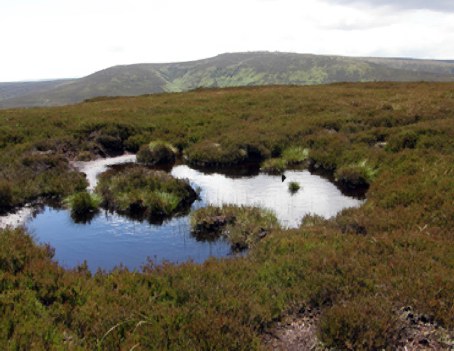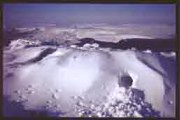Peat Moorlands in the Peak District
Peat moorland one of the landscapes the Peak is best known for, but the term is surprisingly hard to define, although it seems easy to recognise on the ground. What is described here are the plateaus of Kinder and Bleaklow; although most of Derwent Edge, the East Moors and the Roaches area have a similar origin and ecology.
Peat is formed when soft vegetation, mosses and grasses, die but only partially rot. On high ground this is due to low temperatures and water logging. The table below shows the phases of peat formation in the Peak:
Years Ago
|
Cultural Phase
|
Climate vs. late 20th century
|
Peat Formation
|
Vegetation
|
 |
Today
|
Industrial
|
?
|
No - erosion
|
Heather & Grasses, bracken
|
|
200
|
Early industrial
|
Heather & grasses
|
|||
600
|
Medieval
|
Colder
|
Yes
|
Mosses & Grasses
|
|
1,000
|
Warmer
|
||||
2,000
|
Iron Age
|
Colder & Wetter
|
Yes
|
Mosses
|
|
3,500
|
Bronze Age
|
Warmer
|
No
|
Birch & Pine
|
|
5,500
|
Late Stone Age
|
Colder & Wetter
|
Yes
|
Mosses & Grasses
|
|
10,000
|
Sub-Arctic
|
no
|
none
|
Peat was formed from mosses, especially sphagnum, and grasses, in periods which were colder and wetter than those of today. It is often possible to see partly decayed grass being eroded out of peat hags (island) in the deep peat areas of Bleaklow and branches and tree trunks from the periods when the climate allowed tree growth on the plateau can sometimes be found in the upper Derwent, . Upland peat differs from lowland peat in that it most plant nutrients are washed out of it by rain. As a consequence, it is a poor medium for plant growth, especially in periods when summer temperatures are low. Mosses, on the other hand, derive most of their nutrients from rain water and can compete  effectively for light with rooted plants.
effectively for light with rooted plants.
 effectively for light with rooted plants.
effectively for light with rooted plants.Today the plant cover is an artifact - grazing is more intense than could occur in a 'natural' ecology and most moors, either now or in the past, have been affected by management intended to improve grouse shooting. . Heather is encouraged (via selective controlled burning) by gamekeepers as it's young shoots are the primary food for grouse, but bilberry, grasses and mosses are common and found in every mixture depending upon slope, exposure and grazing pressure.

White Edge in winter. Heather at the top of the slope shows as dark brown. Bracken which needs a damp soil but cannot grow in water logged areas grows on gentle slopes and shows as red-brown. Grasses and rushes, adapted to the wet conditions on the near flat areas show as creamy brown.
Copyright @ 2003 Stephen N.Wood. All rights reserved.
This is a Web Counter
This page has been accessed
